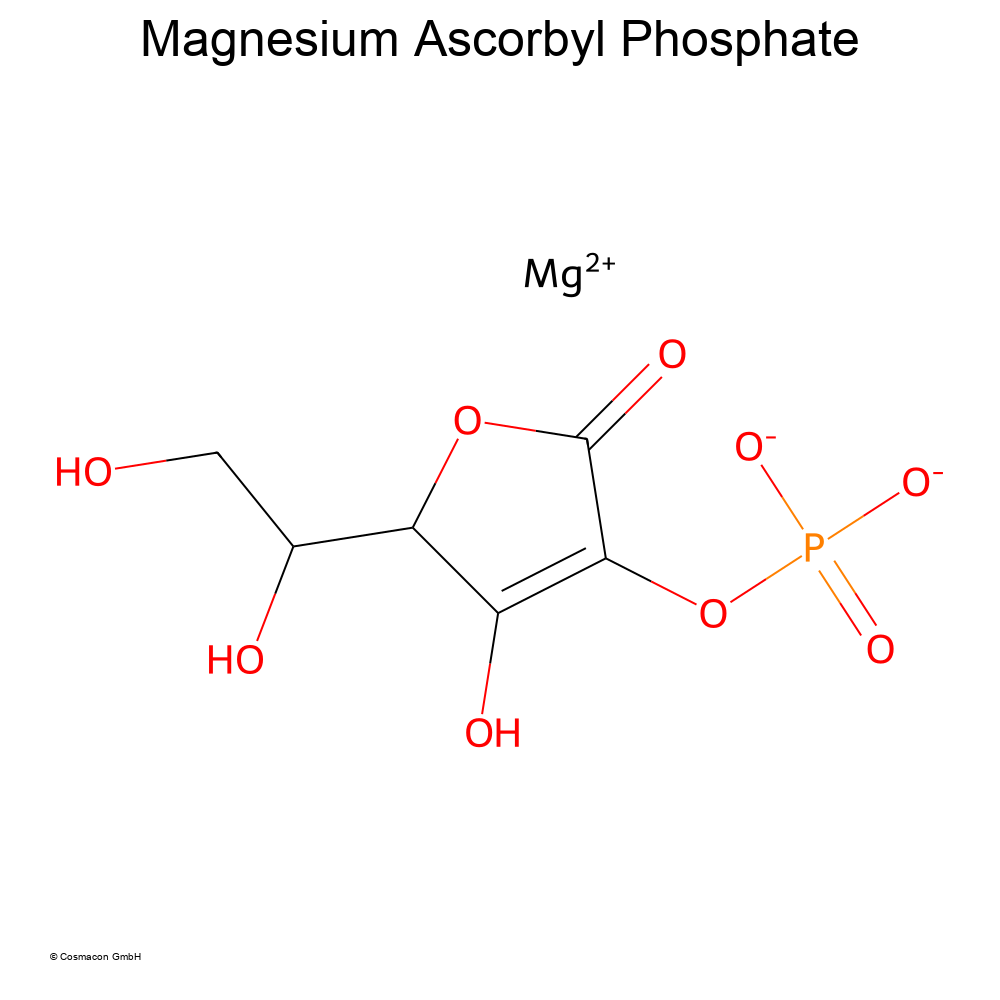Magnesium Ascorbyl Phosphate: A multifunctional active ingredient

Magnesium Ascorbyl Phosphate (MAP) is a stable, water-soluble form of vitamin C that is valued in cosmetics for its numerous benefits. This active ingredient not only offers protection against free radicals, but also promotes collagen production, making it a popular choice for anti-aging products. Compared to pure vitamin C, magnesium ascorbyl phosphate is significantly more stable and is better tolerated by sensitive skin.
Chemical and physical properties of magnesium ascorbyl phosphate
INCI name: Magnesium Ascorbyl Phosphate
Alternative names: MAP, Ascorbyl PM, APM Vitamin C-Phosphate
Molecular formula: C6H7MgO9P
Physical state: White powder
Solubility: Freely soluble in water
pH: Optimal stability in slightly acidic to neutral range (>7).
Melting point: Not applicable as it is a hydrated salt.
CAS number: 114040-31-2
These physico-chemical properties makes it ideal for cosmetic formulations that require stability and efficacy.
Mechanisms of action and efficacy
Magnesium Ascorbyl Phosphate exerts its effects primarily through the following mechanisms:
Antioxidant effect: MAP neutralizes free radicals and protects the skin from oxidative stress, one of the main causes of skin aging.
Collagen synthesis: The active ingredient stimulates the production of collagen, which leads to firmer and more elastic skin.
Lightening of skin tone: MAP inhibits melanin production, which reduces pigment spots and brightens the complexion.
Studies show that Magnesium Ascorbyl Phosphate is effective in concentrations of 1–8 %. In this range, it optimally unfolds its antioxidant and skin-lightening effects without irritating the skin. This makes the active ingredient suitable for sensitive skin.
Advantages of magnesium ascorbyl phosphate
Stability: Unlike L-ascorbic acid, MAP oxidizes more slowly and retains its efficacy for a longer period of time.
Skin-friendliness: The active ingredient is particularly suitable for sensitive skin and is less likely to cause irritation.
Wide range of applications: MAP is versatile, with uses ranging from anti-aging products to gels, creams, and serums for uneven skin tone.
Water solubility: MAP is easy to work into aqueous formulations, making it ideal for modern cosmetic products.
Disadvantages of magnesium ascorbyl phosphate
Cost: MAP is more expensive to produce than simpler forms of vitamin C.
Concentration limits: High concentrations above 5% may affect formulation stability or cause slight skin irritation.
Limited lipid solubility: MAP is less suitable for oily or water-free formulations.
Ideas for cosmetic products with magnesium ascorbyl phosphate
Magnesium ascorbyl phosphate is ideal for a wide variety of cosmetic products. Here are some suggestions:
Anti-aging serums: Use 5% MAP to firm and smooth the skin.
Brightening face creams: Combine MAP with niacinamide to reduce the appearance of dark spots.
Sun care products: combining MAP with UV filters for advanced protection against UV damage.
Eye care: a gentle gel with MAP to reduce dark circles and fine lines.
Moisturizing sprays: with MAP and hyaluronic acid for an instant boost of moisture and antioxidants.
Summary
Magnesium Ascorbyl Phosphate is an innovative and versatile active ingredient that stands for stability, efficacy and tolerability in skin care. Its ability to stimulate collagen production, brighten skin and protect against free radicals makes it an essential ingredient in modern cosmetic formulations.
Cosmacon GmbH can develop customized products based on this active ingredient that give your brand a competitive advantage. Whether it’s an anti-aging serum, a brightening day cream, or a protective sun care product, we develop innovative formulations for you that are tailored to the needs of your customers. Contact us and let’s shape the future of skin care together.
Literature:
Lee WJ, Kim SL, Choe YS, Jang YH, Lee SJ, Kim DW.Ann Dermatol. 2015 Aug;27(4):376-82